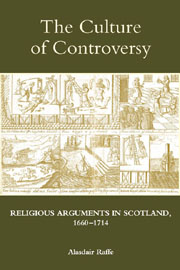Book contents
- Frontmatter
- Contents
- List of Maps and Illustrations
- Acknowledgements
- Abbreviations and Conventions
- Map 1 Scottish counties
- Map 2 Presbyteries, 1660–1714
- Introduction
- 1 The Culture of Controversy
- 2 Religious Groups and Cultures
- Part I Controversial Discourse
- Part II Controversial Action
- Conclusion: Concepts and Consequences
- Glossary
- Bibliography
- Index
- STUDIES IN MODERN BRITISH RELIGIOUS HISTORY
2 - Religious Groups and Cultures
from Introduction
Published online by Cambridge University Press: 05 February 2013
- Frontmatter
- Contents
- List of Maps and Illustrations
- Acknowledgements
- Abbreviations and Conventions
- Map 1 Scottish counties
- Map 2 Presbyteries, 1660–1714
- Introduction
- 1 The Culture of Controversy
- 2 Religious Groups and Cultures
- Part I Controversial Discourse
- Part II Controversial Action
- Conclusion: Concepts and Consequences
- Glossary
- Bibliography
- Index
- STUDIES IN MODERN BRITISH RELIGIOUS HISTORY
Summary
This chapter introduces late seventeenth- and early eighteenth-century Scotland's rival religious groups. It examines their principles, illustrating the disagreements that gave substance to the culture of controversy. By restoring bishops to the national Church for the first time since the 1630s, the ecclesiastical settlement of 1661–2 divided the great majority of the Scottish population into two groups: presbyterians and episcopalians. Members of these groups became rivals and opponents, engaged in lively and often bitter arguments. The re-establishment of presbyterianism in 1690, though a major turning point, did not end the contention between the groups. In terms of printed polemic at least, the Williamite revolution increased the controversy's vigour. It was not until the Jacobite rising of 1715, in which many lay episcopalians and their ministers were involved, that one side was seriously weakened, and the intensity of debate declined.
We begin with the re-establishment of episcopacy, a Church settlement that was favoured more by laymen – the Scottish nobility, English courtiers, Charles II himself – than by the clergy. The chapter then examines the characteristics of those people who accepted the settlement – episcopalians – and those who objected to it – presbyterians. At first, the groups disagreed about little more than Church government and the extent of the crown's religious authority. Indeed, initially there were few principles distinguishing presbyterians from episcopalians. Much more distinctive were the Roman Catholics and Quakers, the two smaller religious minorities that maintained a presence in Scotland after 1660.
- Type
- Chapter
- Information
- The Culture of ControversyReligious Arguments in Scotland, 1660-1714, pp. 29 - 62Publisher: Boydell & BrewerPrint publication year: 2012



